Investigation on the Toxicity of Nanoparticle Mixture in Rainbow Trout Juveniles
Abstract
1. Introduction
2. Materials and Methods
2.1. Nanomaterial Characterization and Fish Exposure
2.2. Elemental Analysis in Water and in Fish
2.3. Biomarker Assessments
3. Data Analysis
4. Results
5. Discussion
Author Contributions
Funding
Data Availability Statement
Acknowledgments
Conflicts of Interest
References
- Wang, S.; Liu, Z.; Wang, W.; You, H. Fate and transformation of nanoparticles (NPs) in municipal wastewater treatment systems and effects of NPs on the biological treatment of wastewater: A review. RSC Adv. 2017, 7, 37065–37075. [Google Scholar] [CrossRef]
- Gagnon, C.; Turcotte, P.; Turcotte, P.; Gagné, F.; Smyth, S.A. Occurrence and size distribution of silver nanoparticles in wastewater effluents from various treatment processes in Canada. Environ. Sci. Pollut. Res. 2021, 28, 65952–65959. [Google Scholar] [CrossRef] [PubMed]
- Yu, C.; Kim, S.; Jang, M.; Park, C.M.; Yoon, Y. Occurrence and removal of engineered nanoparticles in drinking water treatment and wastewater treatment processes: A review. Environ. Eng. Res. 2022, 27, 210339. [Google Scholar] [CrossRef]
- Kim, J.; Yang, I.S.; Moon, H.J.; Hong, J.W.; Hong, J.H.; Choi, W.H.; Son, H.; Lee, B.C.; Kim, G.B.; Kim, Y. Potential release of nano-carbon black from tire-wear particles through the weathering effect. J. Ind. Eng. Chem. 2021, 96, 322–329. [Google Scholar] [CrossRef]
- Polesel, F.; Farkas, J.; Kjos, M.; Carvalho, P.A.; Flores-Alsina, X.; Gernaey, K.V.; Hansen, S.F.; Plósz, B.G.; Booth, A.M. Occurrence, characterisation and fate of (nano) particulate Ti and Ag in two Norwegian wastewater treatment plants. Water Res. 2018, 141, 19–31. [Google Scholar] [CrossRef]
- Sajith, V.; Sobhan, C.B.; Peterson, G.P. Experimental Investigations on the Effects of Cerium Oxide Nanoparticle Fuel Additives on Biodiesel. Adv. Mech. Eng. 2010, 2, 581407. [Google Scholar] [CrossRef]
- Pollard, Z.A.; Karod, M.; Goldfarb, J.L. Metal leaching from antimicrobial cloth face masks intended to slow the spread of COVID-19. Sci. Rep. 2021, 11, 19216. [Google Scholar] [CrossRef]
- Schirinzi, G.F.; Pérez-Pomeda, I.; Sanchís, J.; Rossini, C.; Farré, M.; Barceló, D. Cytotoxic effects of commonly used nanomaterials and microplastics on cerebral and epithelial human cells. Environ. Res. 2017, 159, 579–587. [Google Scholar] [CrossRef]
- Parsai, T.; Kumar, A. Weight-of-evidence process for assessing human health risk of mixture of metal oxide nanoparticles and corresponding ions in aquatic matrices. Chemosphere 2021, 263, 128289. [Google Scholar] [CrossRef]
- Chen, J.; Li, J.; Jiang, H.; Yu, J.; Wang, H.; Wang, N.; Chen, S.; Mo, W.; Wang, P.; Tanguay, R.L.; et al. Developmental co-exposure of TBBPA and titanium dioxide nanoparticle induced behavioral deficits in larval zebrafish. Ecotoxicol. Environ. Saf. 2021, 215, 112176. [Google Scholar] [CrossRef]
- Iswarya, V.; Bhuvaneshwari, M.; Chandrasekaran, N.; Mukherjee, A. Individual and binary toxicity of anatase and rutile nanoparticles towards Ceriodaphnia dubia. Aquat. Toxicol. 2016, 178, 209–221. [Google Scholar] [CrossRef]
- Auclair, J.; Gagné, F. Shape-Dependent Toxicity of Silver Nanoparticles on Freshwater Cnidarians. Nanomaterials 2022, 12, 3107. [Google Scholar] [CrossRef] [PubMed]
- Auclair, J.; Turcotte, P.; Gagnon, C.; Peyrot, C.; Wilkinson, K.J.; Gagné, F. Toxicological effects of inorganic nanoparticle mixtures in freshwater mussels. Environments 2021, 7, 109–126. [Google Scholar] [CrossRef]
- Louie, S.M.; Tilton, R.D.; Lowry, G.V. Effects of molecular weight distribution and chemical properties of natural organic matter on gold nanoparticle aggregation. Environ. Sci. Technol. 2013, 47, 4245–4254. [Google Scholar] [CrossRef]
- Gagné, F.; André, C.; Skirrow, R.; Gélinas, M.; Auclair, J.; van Aggelen, G.; Turcotte, P.; Gagnon, C. Toxicity of silver nanoparticles to rainbow trout: A toxicogenomic approach. Chemosphere 2012, 89, 615–622. [Google Scholar] [CrossRef]
- Canesi, L.; Corsi, I. Effects of nanomaterials on marine invertebrates. Sci. Total Environ. 2016, 565, 933–940. [Google Scholar] [CrossRef]
- Song, L.; Vijver, M.G.; Peijnenburg, W.J.; Galloway, T.S.; Tyler, C.R. A comparative analysis on the in vivo toxicity of copper nanoparticles in three species of freshwater fish. Chemosphere 2015, 139, 181–189. [Google Scholar] [CrossRef] [PubMed]
- Adam, N.; Schmitt, C.; De Bruyn, L.; Knapen, D.; Blust, R. Aquatic acute species sensitivity distributions of ZnO and CuO nanoparticles. Sci. Total Environ. 2015, 526, 233–242. [Google Scholar] [CrossRef]
- Gagné, F. Ecotoxicology of altered fractal organization in cells. Am. J. Biomed. Sci. Res. 2020, 8, 498–502. [Google Scholar] [CrossRef]
- Hernández-Moreno, D.; Valdehita, A.; Conde, E.; Rucandio, I.; Navas, J.M.; Fernández-Cruz, M.L. Acute toxic effects caused by the co-exposure of nanoparticles of ZnO and Cu in rainbow trout. Sci. Total Environ. 2019, 687, 24–33. [Google Scholar] [CrossRef]
- Gagnon, C.; Bruneau, A.; Turcotte, P.; Pilote, M.; Gagné, F. Fate of cerium oxide nanoparticles in natural waters and immunotoxicity in exposed rainbow rrout. J. Nanomed. Nanotechnol. 2018, 9, 489–497. [Google Scholar] [CrossRef]
- Mahjoubian, M.; Naeemi, A.S.; Moradi-Shoeili, Z.; Tyler, C.R.; Mansouri, B. Toxicity of Silver Nanoparticles in the Presence of Zinc Oxide Nanoparticles Differs for Acute and Chronic Exposures in Zebrafish. Arch. Environ. Contam. Toxicol. 2022. [Google Scholar] [CrossRef] [PubMed]
- Baalousha, M. Sewage spills are a major source of titanium dioxide engineered (nano)-particles into the environment. Environ. Sci. Nano 2019, 6, 763–777. [Google Scholar]
- Du, P.; Zhang, L.; Ma, Y.; Li, X.; Wang, Z.; Mao, K.; Wang, N.; Li, Y.; He, J.; Zhang, X. Occurrence and Fate of Heavy Metals in Municipal Wastewater in Heilongjiang Province, China: A Monthly Reconnaissance from 2015 to 2017. Water 2020, 12, 728. [Google Scholar] [CrossRef]
- Bradford, M.M. A rapid and sensitive method for the quantitation of microgram quantities of protein utilizing the principle of protein-dye binding. Anal. Biochem. 1976, 72, 248–254. [Google Scholar] [CrossRef]
- Wills, E.D. Evaluation of lipid peroxidation in lipids and biological membranes. In Biochemical Toxicology: A Practical Approach; Snell, K., Mullock, B., Eds.; IRL Press: Washington, DC, USA, 1987; p. 127. [Google Scholar]
- Olive, P.L. DNA precipitation assay: A rapid and simple method for detecting DNA damage in mammalian cells. Environ. Mol. Mutagenes. 1988, 11, 487–495. [Google Scholar] [CrossRef] [PubMed]
- Bester, M.J.; Potgieter, H.C.; Vermaak, W.J.H. Cholate and pH reduce interference by SDS in the determination of DNA with Hoescht. Anal. Biochem. 1994, 223, 299–305. [Google Scholar] [CrossRef]
- Gagné, F.; Blaise, C. Genotoxicity of environmental contaminants in sediments to rainbow trout hepatocytes. Environ. Toxicol. Water Qual. 1995, 10, 217–229. [Google Scholar] [CrossRef]
- Gagné, F.; Blaise, C. Available intracellular zinc as a potential indicator of heavy metal exposure in rainbow trout hepatocytes. Environ. Toxicol. Water Qual. 1996, 11, 319–325. [Google Scholar] [CrossRef]
- Auclair, J. Metal Metabolism and Detoxification. In Biochemical Ecotoxicology: Principle and Methods; Elsevier Inc.: New York, NY, USA, 2014; pp. 84–98. [Google Scholar]
- Bruneau, A.; Turcotte, P.; Pilote, M.; Gagné, F.; Gagnon, C. Fate and Immunotoxic Effects of silver nanoparticles on rainbow trout in natural waters. J. Nanomed. Nanotechnol. 2016, 6, 290. [Google Scholar]
- Bai, W.; Tian, W.; Zhang, Z.; He, X.; Ma, Y.; Liu, N.; Chai, Z. Effects of copper nanoparticles on the development of zebrafish embryos. J. Nanosci. Nanotechnol. 2010, 10, 8670–8676. [Google Scholar] [CrossRef]
- Auclair, J.; Turcotte, P.; Gagnon, C.; Peyrot, C.; Wilkinson, K.J.; Gagné, F. Comparative toxicity of copper oxide nanoparticles and dissolved copper to freshwater mussels. Intern. J. Zool. Investig. 2020, 6, 135–147. [Google Scholar]
- Oliveira, E.; Santos, H.M.; Garcia-Pardo, J.; Diniz, M.; Lorenzo, J.; Rodríguez-González, B.; Capelo, J.L.; Lodeiro, C. Synthesis of functionalized fluorescent silver nanoparticles and their toxicological effect in aquatic environments (Goldfish) and HEPG2 cells. Front. Chem. 2013, 1, 29. [Google Scholar] [CrossRef] [PubMed]
- Zhang, H.; He, X.; Zhang, Z.; Zhang, P.; Li, Y.; Ma, Y.; Kuang, Y.; Zhao, Y.; Chai, Z. Nano-CeO2 exhibits adverse effects at environmental relevant concentrations. Environ. Sci. Technol. 2011, 45, 3725–3730. [Google Scholar] [CrossRef] [PubMed]
- Khan, M.S.; Qureshi, N.A.; Jabeen, F. Ameliorative role of nano-ceria against amine coated Ag-NP induced toxicity in Labeo rohita. Appl. Nanosci. 2018, 8, 323–337. [Google Scholar] [CrossRef]
- Bhagat, S.; Vallabani, N.V.S.; Shutthanandan, V.; Bowden, M.; Karakoti, A.S.; Singh, S. Gold core/ceria shell-based redox active nanozyme mimicking the biological multienzyme complex phenomenon. J. Coll. Int. Sci. 2018, 513, 831–842. [Google Scholar] [CrossRef]
- Gagné, F.; Auclair, J.; Turcotte, P.; Gagnon, C. Sublethal effects of silver nanoparticles and dissolved silver in freshwater mussels. J. Toxicol. Environ. Health A 2013, 76, 479–490. [Google Scholar] [CrossRef]
- Barreto, A.; Luis, L.G.; Pinto, E.; Almeida, A.; Paíga, P.; Santos, L.H.M.L.M.; Delerue-Matos, C.; Trindade, T.; Soares, A.M.V.M.; Hylland, K.; et al. Genotoxicity of gold nanoparticles in the gilthead seabream (Sparus aurata) after single exposure and combined with the pharmaceutical gemfibrozil. Chemosphere 2019, 220, 11–19. [Google Scholar] [CrossRef]
- Ozansoy, G.; Akin, B.; Aktan, F.; Karasu, C. Short-term gemfibrozil treatment reverses lipid profile and peroxidation but does not alter blood glucose and tissue antioxidant enzymes in chronically diabetic rats. Mol. Cell. Biochem. 2001, 216, 59–63. [Google Scholar] [CrossRef]
- Ogunsuyi, O.I.; Fadoju, O.M.; Akanni, O.O.; Alabi, O.A.; Alimba, C.G.; Cambier, S.; Eswara, S.; Gutleb, A.C.; Adaramoye, O.A.; Bakare, A.A. Genetic and systemic toxicity induced by silver and copper oxide nanoparticles, and their mixture in Clarias gariepinus (Burchell, 1822). Environ. Sci. Pollut. Res. Int. 2019, 26, 27470–27481. [Google Scholar] [CrossRef]
- Kukla, S.P.; Chelomin, V.P.; Mazur, A.A.; Slobodskova, V.V. Zinc Oxide Nanoparticles Induce DNA Damage in Sand Dollar Scaphechinus mirabilis Sperm. Toxics 2022, 10, 348. [Google Scholar] [CrossRef]
- Kaur, J.; Khatri, M.; Puri, S. Toxicological evaluation of metal oxide nanoparticles and mixed exposures at low doses using zebra fish and THP1 cell line. Environ. Toxicol. 2019, 34, 375–387. [Google Scholar] [CrossRef]
- Mansouri, B.; Maleki, A.; Davari, B.; Johari, S.A.; Shahmoradi, B.; Mohammadi, E.; Shahsavari, S. Histopathological effects following short-term coexposure of Cyprinus carpio to nanoparticles of TiO2 and CuO. Environ. Monit Assess 2016, 188, 575. [Google Scholar] [CrossRef] [PubMed]
- Hernández-Moreno, D.; Li, L.; Connolly, M.; Conde, E.; Fernández, M.; Schuster, M.; Navas, J.M.; Fernández-Cruz, M.-L. Mechanisms underlying the enhancement of toxicity caused by the coincubation of zinc oxide and copper nanoparticles in a fish hepatoma cell line. Environ. Toxicol. Chem. 2016, 35, 2562–2570. [Google Scholar] [CrossRef] [PubMed]
- Haghighat, F.; Kim, Y.; Sourinejad, I.; Yu, I.J.; Johari, S.A. Titanium dioxide nanoparticles affect the toxicity of silver nanoparticles in common carp (Cyprinus carpio). Chemosphere 2021, 262, 127805. [Google Scholar] [CrossRef]
- Zhang, H.; Shi, J.; Su, Y.; Li, W.; Wilkinson, K.J.; Xie, B. Acute toxicity evaluation of nanoparticles mixtures using luminescent bacteria. Environ. Monit. Assess. 2020, 192, 484. [Google Scholar] [CrossRef] [PubMed]
- Pikula, K.; Johari, S.A.; Santos-Oliveira, R.; Golokhvast, K. Individual and binary mixture toxicity of five nanoparticles in marine microalga Heterosigma akashiwo. Int. J. Mol. Sci. 2022, 23, 990. [Google Scholar] [CrossRef]
- Wang, Z.; Zhao, J.; Li, F.; Gao, D.; Xing, B. Adsorption and inhibition of acetylcholinesterase by different nanoparticles. Chemosphere 2009, 77, 67–73. [Google Scholar] [CrossRef]
- Kokturk, M.; Yıldırım, S.; Atamanalp, M.; Calimli, M.H.; Nas, M.S.; Bolat, I.; Ozhan, G.; Alak, G. Assessment of oxidative DNA damage, apoptosis and histopathological alterations on zebrafish exposed with green silver nanoparticle. Chem. Ecol. 2022, 38, 655–670. [Google Scholar] [CrossRef]
- Ucar, A.; Parlak, V.; Ozgeris, F.B.; Yeltekin, A.C.; Arslan, M.E.; Alak, G.; Turkez, H.; Kocaman, E.M.; Atamanalp, M. Magnetic nanoparticles-induced neurotoxicity and oxidative stress in brain of rainbow trout: Mitigation by ulexite through modulation of antioxidant, anti-inflammatory, and antiapoptotic activities. Sci. Total Environ. 2022, 838, 155718. [Google Scholar] [CrossRef]
- Sellami, B.; Bouzidi, I.; Hedfi, A.; Almalki, M.; Rizk, R.; Pacioglu, O.; Boufahja, F.; Beyrem, H.; David Sheehan, D. Impacts of nanoparticles and phosphonates in the behavior and oxidative status of the mediterranean mussels (Mytilus galloprovincialis). Saudi J. Biol. Sci. 2021, 28, 6365–6374. [Google Scholar] [CrossRef] [PubMed]
- Xia, J.; Zhao, H.Z.; Lu, G.H. Effects of selected metal oxide nanoparticles on multiple biomarkers in Carassius auratus. Biomed. Environ. Sci. 2013, 26, 742–749. [Google Scholar] [PubMed]
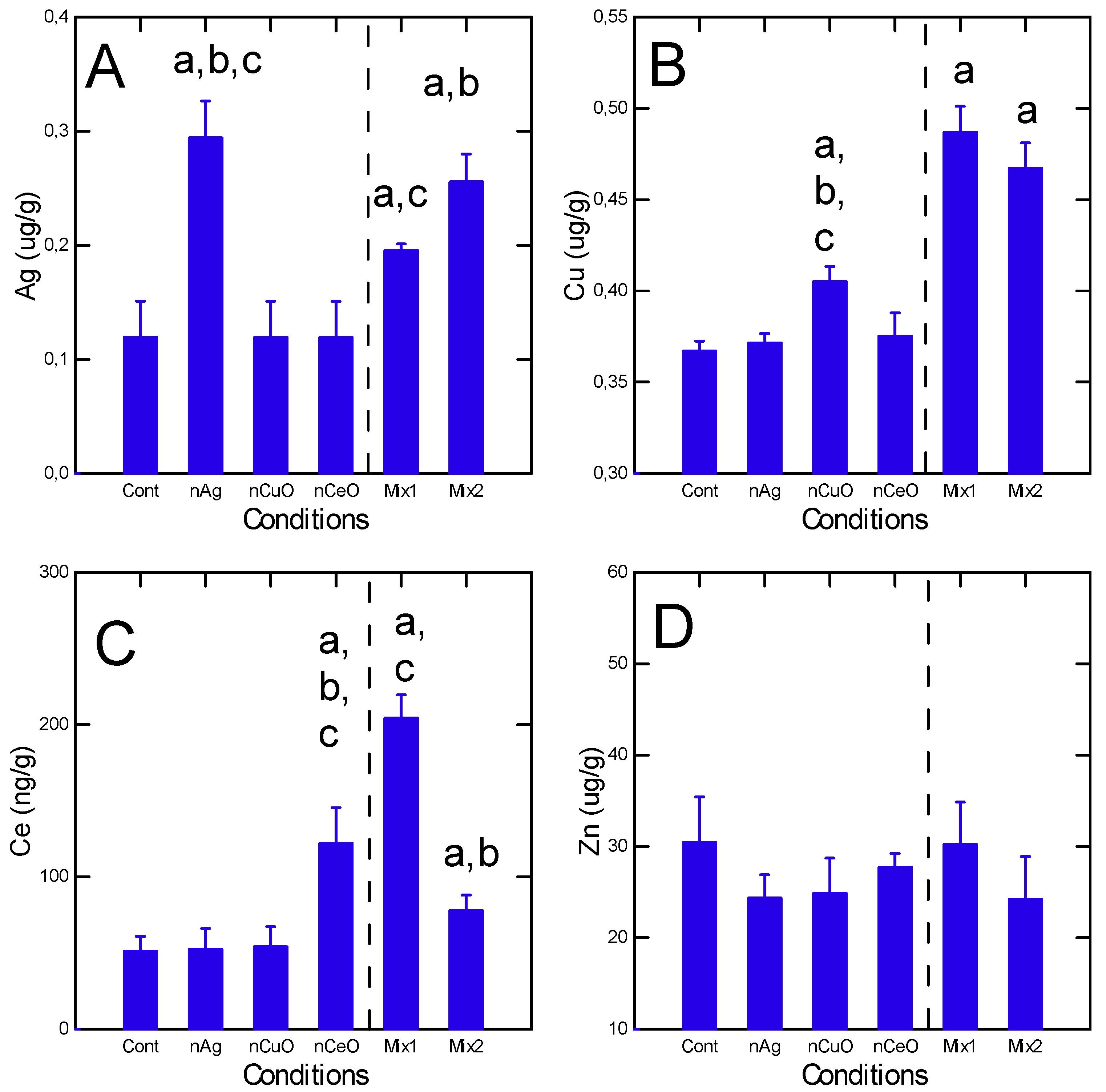
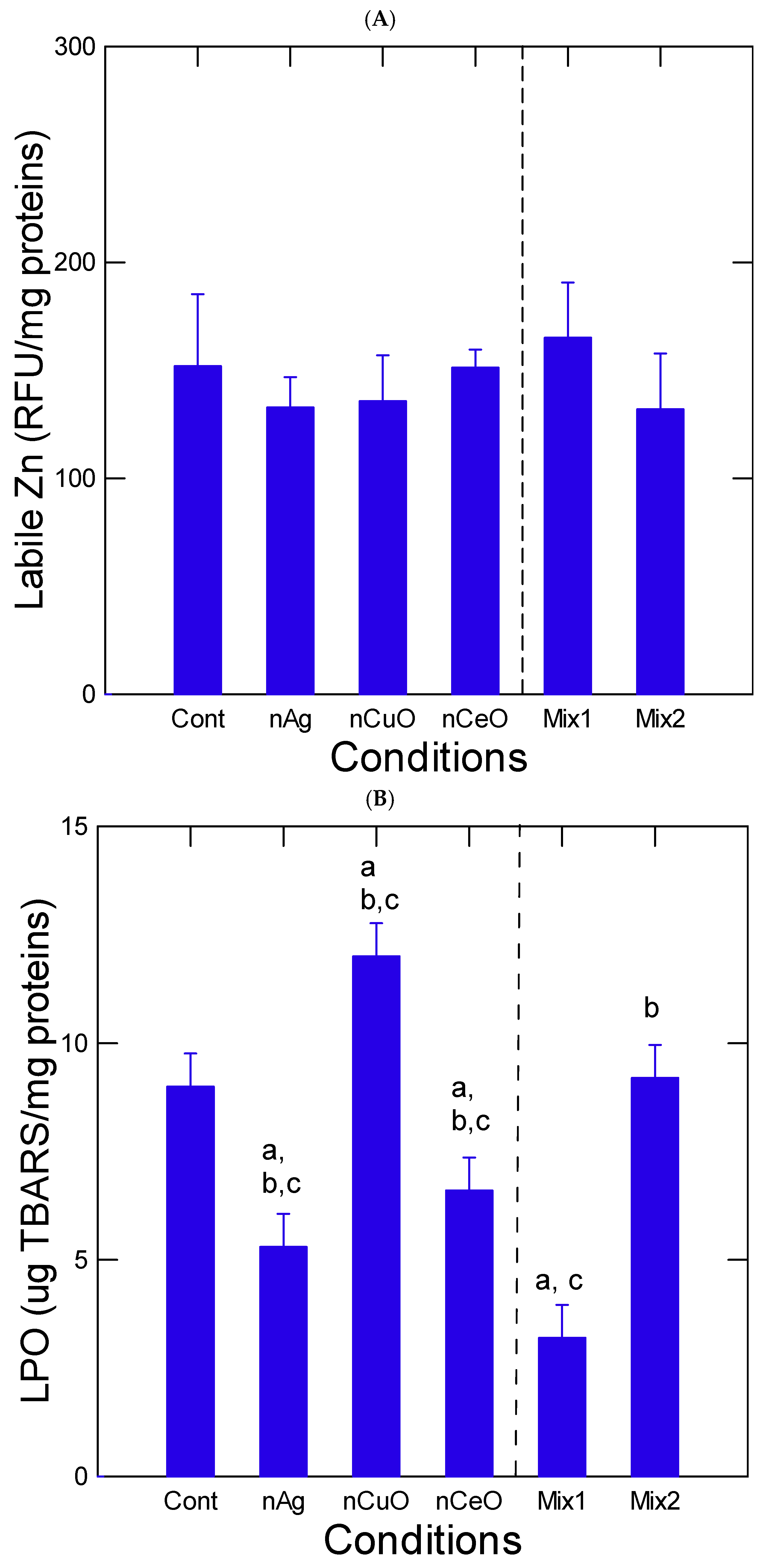
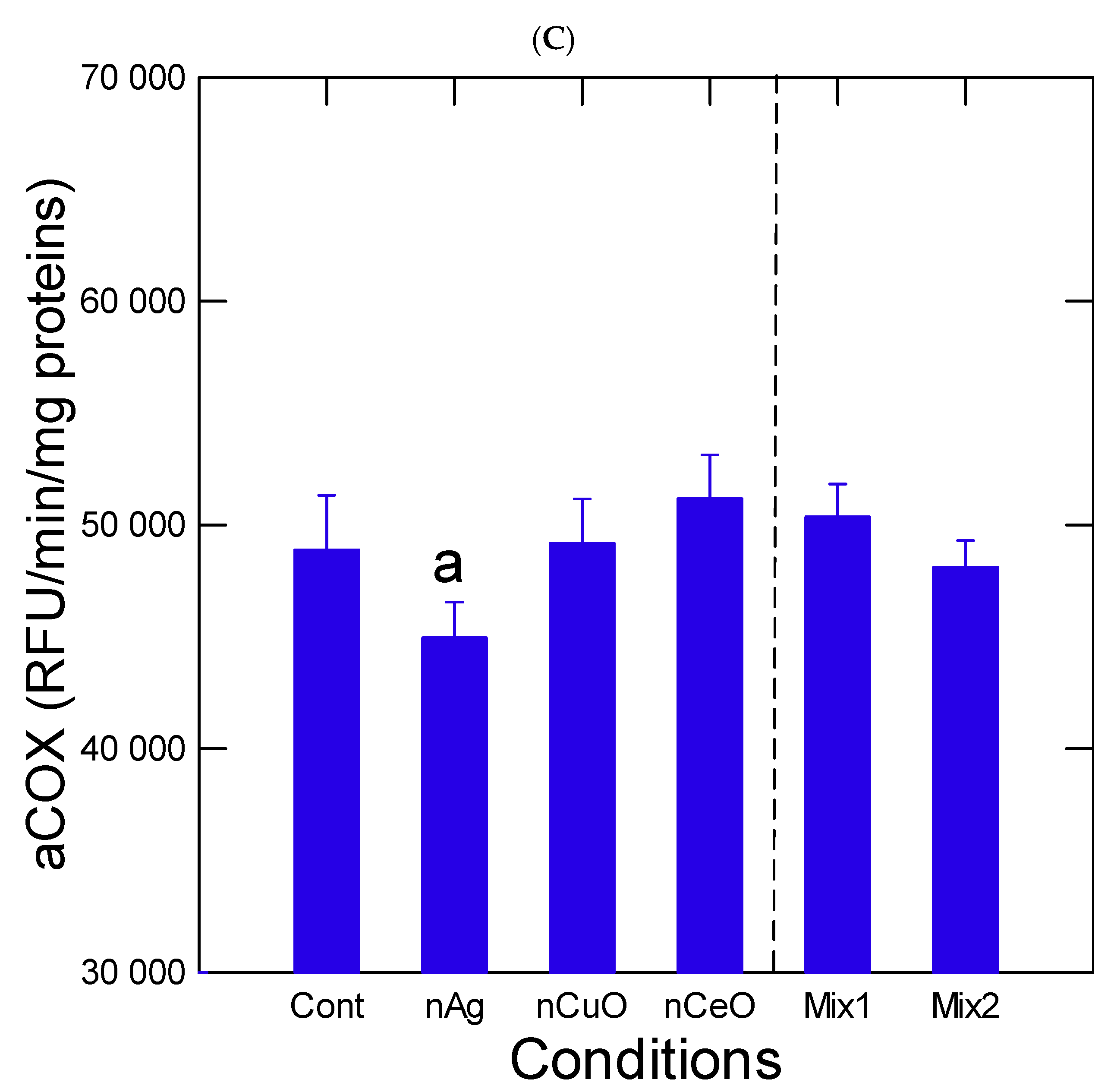
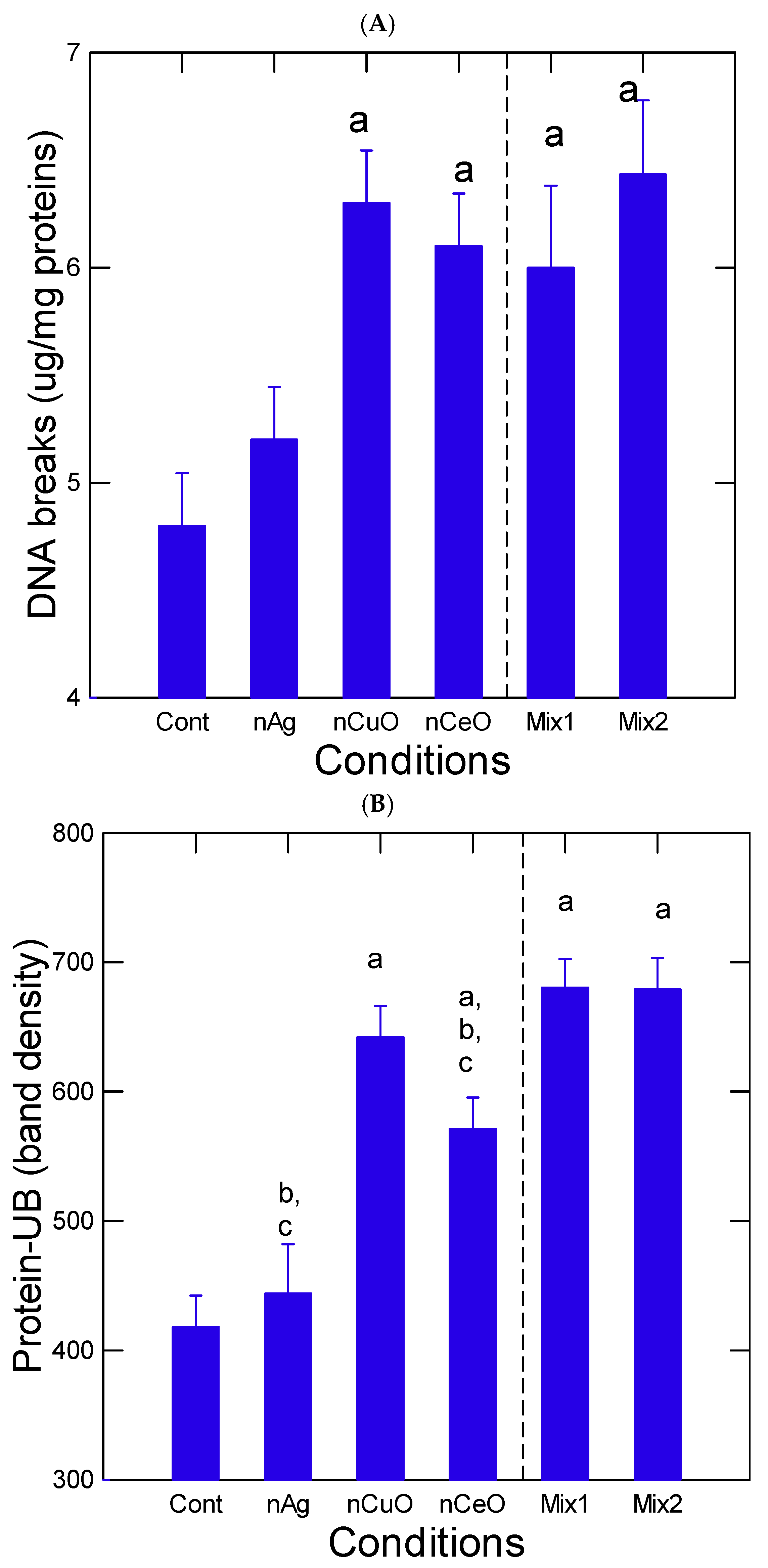
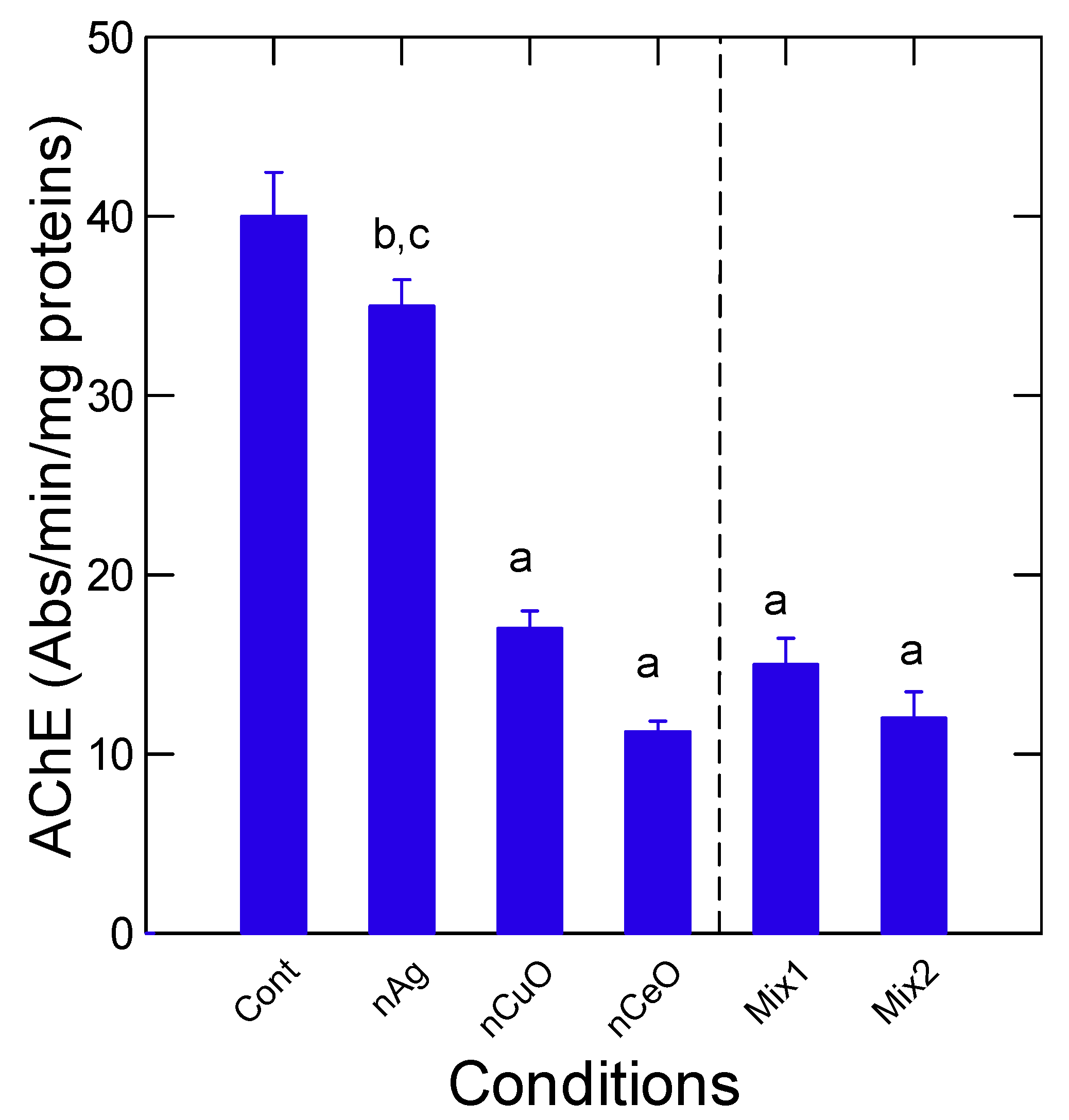
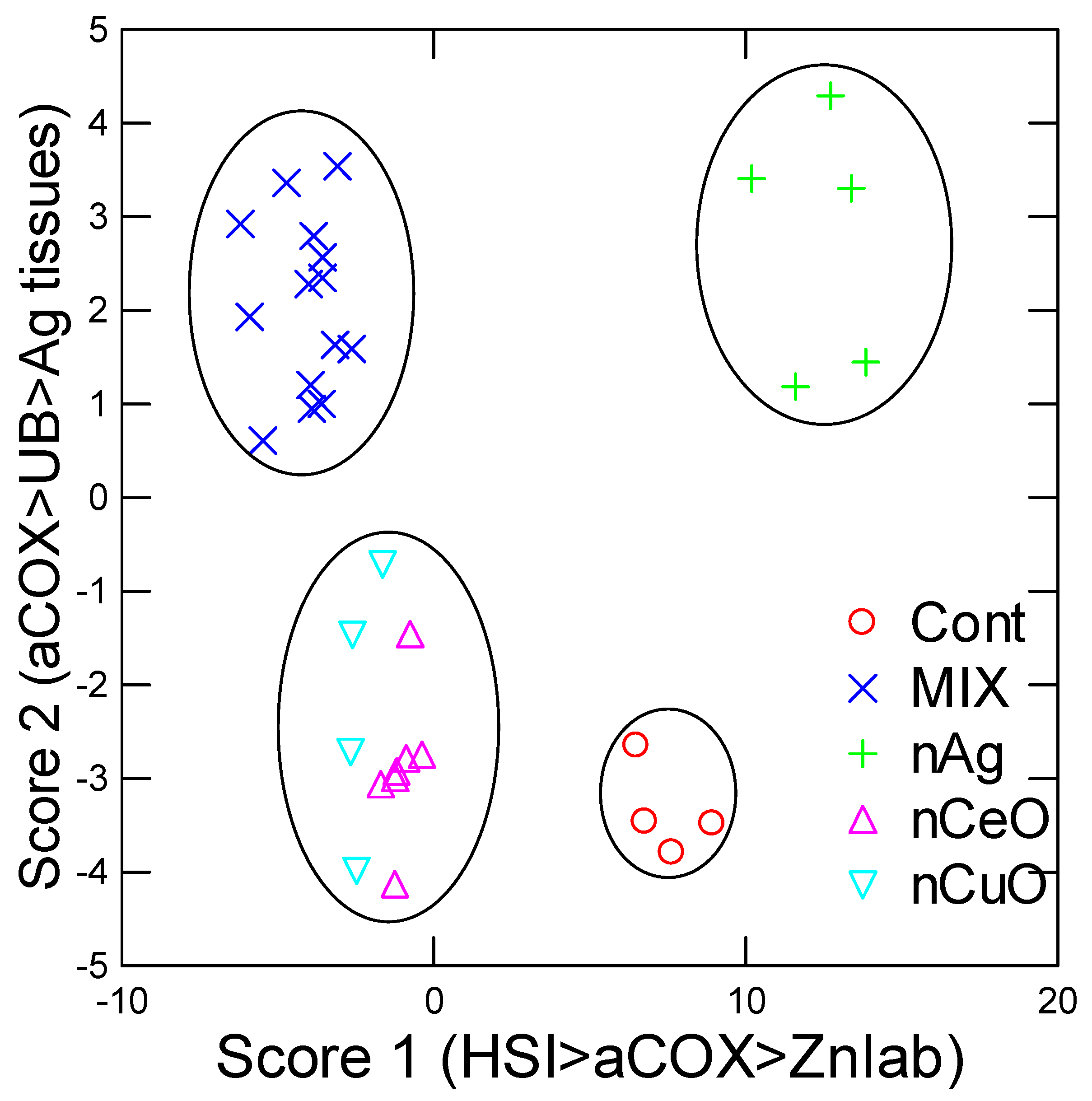
| Mean Diameter (nm)/Zeta Potential (mv) | Ag (µg/L) 1 h 96 h | Cu (µg/L) 1 h 96 h | Ce (µg/L) 1 h 96 h | |
|---|---|---|---|---|
| nAg 50 μg/L | 52 ± 8/−45 | 48 33 | - - | - - |
| nCuO 50 μg/L | 60 ± 7/−14 | - - | 3.5 4.2 | - - |
| nCeO 10 μg/L | 50 ± 10/−18 | - - | - - | 1.2 0.75 |
| Mix 1 | - | 16 9 | 1.6 1.9 | 0.2 0.02 |
| Mix 2 | - | 49 29 | 3.3 2.3 | 1.3 0.35 |
| Controls (aquarium) | - | 0.02 0.01 | 1 1.3 | 0.01 0.004 |
| Treatment | CF | HSI | Gill Somatic Index |
|---|---|---|---|
| Control | 1.02 ± 0.02 | 0.01 ± 0.001 | 0.05 ± 0.004 |
| nCuO | 1.04 ± 0.04 | 0.05 ± 0.002 ac | 0.01 ± 0.001 a |
| 5nCeO | 1.03 ± 0.02 | 0.04 ± 0.003 a | 0.01 ± 0.001 a |
| nAg | 1.02 ± 0.01 | 0.01 ± 0.001 bc | 0.05 ± 0.003 bc |
| Mixture 1 (45 µg/L total) | 1.02 ± 0.02 | 0.05 ± 0.003 a | 0.01 ± 0.001 a |
| Mixture 2 (120 µg/L total) | 1.16 ± 0.08 | 0.04 ± 0.003 a | 0.01 ± 0.001 a |
Disclaimer/Publisher’s Note: The statements, opinions and data contained in all publications are solely those of the individual author(s) and contributor(s) and not of MDPI and/or the editor(s). MDPI and/or the editor(s) disclaim responsibility for any injury to people or property resulting from any ideas, methods, instructions or products referred to in the content. |
© 2023 by the authors. Licensee MDPI, Basel, Switzerland. This article is an open access article distributed under the terms and conditions of the Creative Commons Attribution (CC BY) license (https://creativecommons.org/licenses/by/4.0/).
Share and Cite
Auclair, J.; Turcotte, P.; Gagnon, C.; Peyrot, C.; Wilkinson, K.J.; Gagné, F. Investigation on the Toxicity of Nanoparticle Mixture in Rainbow Trout Juveniles. Nanomaterials 2023, 13, 311. https://doi.org/10.3390/nano13020311
Auclair J, Turcotte P, Gagnon C, Peyrot C, Wilkinson KJ, Gagné F. Investigation on the Toxicity of Nanoparticle Mixture in Rainbow Trout Juveniles. Nanomaterials. 2023; 13(2):311. https://doi.org/10.3390/nano13020311
Chicago/Turabian StyleAuclair, Joelle, Patrice Turcotte, Christian Gagnon, Caroline Peyrot, Kevin James Wilkinson, and François Gagné. 2023. "Investigation on the Toxicity of Nanoparticle Mixture in Rainbow Trout Juveniles" Nanomaterials 13, no. 2: 311. https://doi.org/10.3390/nano13020311
APA StyleAuclair, J., Turcotte, P., Gagnon, C., Peyrot, C., Wilkinson, K. J., & Gagné, F. (2023). Investigation on the Toxicity of Nanoparticle Mixture in Rainbow Trout Juveniles. Nanomaterials, 13(2), 311. https://doi.org/10.3390/nano13020311







